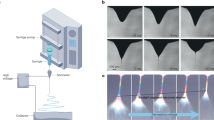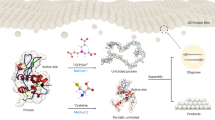Abstract
As engineers strive to mimic the form and function of naturally occurring materials with synthetic alternatives, the challenges and costs of processing often limit creative innovation. Here we describe a powerful yet economical technique for developing multiple coatings of different morphologies and functions within a single textile membrane, enabling scientists to engineer the properties of a material from the nanoscopic level in commercially viable quantities. By simply varying the flow rate of charged species passing through an electrospun material during spray-assisted layer-by-layer deposition, individual fibres within the matrix can be conformally functionalized for ultrahigh-surface-area catalysis, or bridged to form a networked sublayer with complimentary properties. Exemplified here by the creation of selectively reactive gas purification membranes, the myriad applications of this technology also include self-cleaning fabrics, water purification and protein functionalization of scaffolds for tissue engineering.
This is a preview of subscription content, access via your institution
Access options
Subscribe to this journal
Receive 12 print issues and online access
$259.00 per year
only $21.58 per issue
Buy this article
- Purchase on Springer Link
- Instant access to full article PDF
Prices may be subject to local taxes which are calculated during checkout





Similar content being viewed by others
References
Bretsche, M. S. Membrane structure—some general principles. Science 181, 622–629 (1973).
Rothman, J. E. & Lenard, J. Membrane asymmetry. Science 195, 743–753 (1977).
Sridhar, S., Smitha, B. & Aminabhavi, T. M. Separation of carbon dioxide from natural gas mixtures through polymeric membranes—a review. Sep. Purif. Rev. 36, 113–174 (2007).
Decher, G. Fuzzy nanoassemblies: Toward layered polymeric multicomposites. Science 277, 1232–1237 (1997).
Shiratori, S. S. & Rubner, M. F. pH-dependent thickness behavior of sequentially adsorbed layers of weak polyelectrolytes. Macromolecules 33, 4213–4219 (2000).
Dubas, S. T. & Schlenoff, J. B. Factors controlling the growth of polyelectrolyte multilayers. Macromolecules 32, 8153–8160 (1999).
Lee, D., Rubner, M. F. & Cohen, R. E. All-nanoparticle thin-film coatings. Nano Lett. 6, 2305–2312 (2006).
Lvov, Y., Ariga, K., Onda, M., Ichinose, I. & Kunitake, T. Alternate assembly of ordered multilayers of SiO2 and other nanoparticles and polyions. Langmuir 13, 6195–6203 (1997).
Iler, R. K. Multilayers of colloidal particles. J. Colloid Interface Sci. 21, 569–594 (1966).
Caruso, F., Caruso, R. A. & Mohwald, H. Nanoengineering of inorganic and hybrid hollow spheres by colloidal templating. Science 282, 1111–1114 (1998).
Yoo, P. J. et al. Spontaneous assembly of viruses on multilayered polymer surfaces. Nature Mater. 5, 234–240 (2006).
Tang, Z. Y., Wang, Y., Podsiadlo, P. & Kotov, N. A. Biomedical applications of layer-by-layer assembly: From biomimetics to tissue engineering. Adv. Mater. 18, 3203–3224 (2006).
Hammond, P. T. Form and function in multilayer assembly: New applications at the nanoscale. Adv. Mater. 16, 1271–1293 (2004).
Schlenoff, J. B., Dubas, S. T. & Farhat, T. Sprayed polyelectrolyte multilayers. Langmuir 16, 9968–9969 (2000).
Izquierdo, A., Ono, S. S., Voegel, J. C., Schaaff, P. & Decher, G. Dipping versus spraying: Exploring the deposition conditions for speeding up layer-by-layer assembly. Langmuir 21, 7558–7567 (2005).
Krogman, K. C., Zacharia, N. S., Schroeder, S. & Hammond, P. T. Automated process for improved uniformity and versatility of layer-by-layer deposition. Langmuir 23, 3137–3141 (2007).
Fridrikh, S. V., Yu, J. H., Brenner, M. P. & Rutledge, G. C. Controlling the fiber diameter during electrospinning. Phys. Rev. Lett. 90, 144502 (2003).
Chen, L., Bromberg, L., Hatton, T. A. & Rutledge, G. C. Electrospun cellulose acetate fibers containing chlorhexidine as a bactericide. Polymer 49, 1266–1275 (2008).
Lee, J. A. et al. Highly reactive multilayer-assembled TiO2 coating on electrospun polymer nanofibers. Adv. Mater. 21, 1252–1256 (2009).
Chen, L. et al. Chemical protection fabrics via surface oximation of electrospun polyacrylonitrile fiber mats. J. Mater. Chem. (2009, in the press).
Blossey, R. Self-cleaning surfaces—virtual realities. Nature Mater. 2, 301–306 (2003).
Daoud, W. A. et al. Self-cleaning keratins. Chem. Mater. 20, 1242–1244 (2008).
Peercy, P. S. The drive to miniaturization. Nature 406, 1023–1026 (2000).
Simon, P. & Gogotsi, Y. Materials for electrochemical capacitors. Nature Mater. 7, 845–854 (2008).
Tarascon, J. M. & Armand, M. Issues and challenges facing rechargeable lithium batteries. Nature 414, 359–367 (2001).
Yoon, J. et al. Ultrathin silicon solar microcells for semitransparent, mechanically flexible and microconcentrator module designs. Nature Mater. 7, 907–915 (2008).
Shin, Y. M., Hohman, M. M., Brenner, M. P. & Rutledge, G. C. Experimental characterization of electrospinning: The electrically forced jet and instabilities. Polymer 42, 9955–9967 (2001).
Deen, W. M. Analysis of Transport Phenomena 6th edn (Oxford Univ. Press, 1998).
Krogman, K. C., Zacharia, N. S., Grillo, D. M. & Hammond, P. T. Photocatalytic layer-by-layer coatings for degradation of acutely toxic agents. Chem. Mater. 20, 1924–1930 (2008).
Crank, J. The Mathematics of Diffusion 2nd edn (Oxford Univ. Press, 1975).
Frisch, H. L. Time lag in transport theory. J. Chem. Phys. 36, 510–516 (1962).
Wijmans, J. G. & Baker, R. W. The solution-diffusion model: A review. J. Membrane Sci. 107, 1–21 (1995).
Peinemann, K., Abetz, V. & Simon, P. F. W. Asymmetric superstructure formed in a block copolymer via phase separation. Nature Mater. 6, 992–996 (2007).
Mi, F. et al. Fabrication and characterization of a sponge-like asymmetric chitosan membrane as a wound dressing. Biomaterials 22, 165–173 (2001).
Shannon, M. A. et al. Science and technology for water purification in the coming decades. Nature 452, 301–310 (2008).
Corry, B. Designing carbon nanotube membranes for efficient water desalination. J. Phys. Chem. B 112, 1427–1434 (2008).
Ma, M. L. et al. Decorated electrospun fibers exhibiting superhydrophobicity. Adv. Mater. 19, 255–259 (2007).
Cao, Q. et al. Medium-scale carbon nanotube thin-film integrated circuits on flexible plastic substrates. Nature 454, 495–500 (2008).
Hall, L. J. et al. Sign change of Poisson’s ratio for carbon nanotube sheets. Science 320, 504–507 (2008).
Barnes, C. P., Sell, S. A., Boland, E. D., Simpson, D. G. & Bowlin, G. L. Nanofiber technology: Designing the next generation of tissue engineering scaffolds. Adv. Drug Delivery Rev. 59, 1413–1433 (2007).
Dankers, P. Y. W., Harmsen, M. C., Brouwer, L. A., Van Luyn, M. J. A. & Meijer, E. W. A modular and supramolecular approach to bioactive scaffolds for tissue engineering. Nature Mater. 4, 568–574 (2005).
Grafahrend, D. et al. Control of protein adsorption on functionalized electrospun fibers. Biotechnol. Bioeng. 101, 609–621 (2008).
Heydarkhan-Hagvall, S., Schenke-Layland, K. & Dhanasopon, A. P. Three-dimensional electrospun ECM-based hybrid scaffolds for cardiovascular tissue engineering. Biomaterials 29, 2907–2914 (2008).
Zhang, X. H., Baughman, C. B. & Kaplan, D. L. In vitro evaluation of electrospun silk fibroin scaffolds for vascular cell growth. Biomaterials 29, 2217–2227 (2008).
Park, J. H., Kim, B. S., Yoo, Y. C., Khil, M. S. & Kim, H. Y. Enhanced mechanical properties of multilayer nano-coated electrospun nylon 6 fibers via a layer-by-layer self-assembly. J. Appl. Polym. Sci. 107, 2211–2216 (2008).
Gibson, P. W., Kendrick, C. E. & Rivin, D. Apparatus and method for determining transport properties of porous materials. US Patent No. 6,119,506 (1999).
Acknowledgements
This research was supported in part by the US Army through the Institute for Soldier Nanotechnologies under contract DAAD-19-02-0002 with the US Army Research Office, and by the G. Nicholas and Dorothea K. Dumbros Scholarship and Fellowship Fund. The content does not necessarily reflect the position of the government, and no official endorsement should be inferred. The authors would like to thank H. Schreuder-Gibson and P. Gibson of the US Army Soldier Systems Center for assistance with water-vapour permeation testing.
Author information
Authors and Affiliations
Corresponding author
Supplementary information
Supplementary Information
Supplementary Information (PDF 437 kb)
Rights and permissions
About this article
Cite this article
Krogman, K., Lowery, J., Zacharia, N. et al. Spraying asymmetry into functional membranes layer-by-layer. Nature Mater 8, 512–518 (2009). https://doi.org/10.1038/nmat2430
Received:
Accepted:
Published:
Issue Date:
DOI: https://doi.org/10.1038/nmat2430
This article is cited by
-
Recent development and application of membrane chromatography
Analytical and Bioanalytical Chemistry (2023)
-
Advances in layer-by-layer self-assembled coatings upon biodegradable magnesium alloys
Science China Materials (2021)
-
Sponge-templating synthesis of sandwich-like reduced graphene oxide nanoplates with confined gold nanoparticles and their enhanced stability for solar evaporation
Science China Materials (2020)
-
Layer-by-layer self-assembly of pillared two-dimensional multilayers
Nature Communications (2019)
-
Highly stretchable and sensitive strain sensors based on single-walled carbon nanotube-coated nylon textile
Korean Journal of Chemical Engineering (2019)



